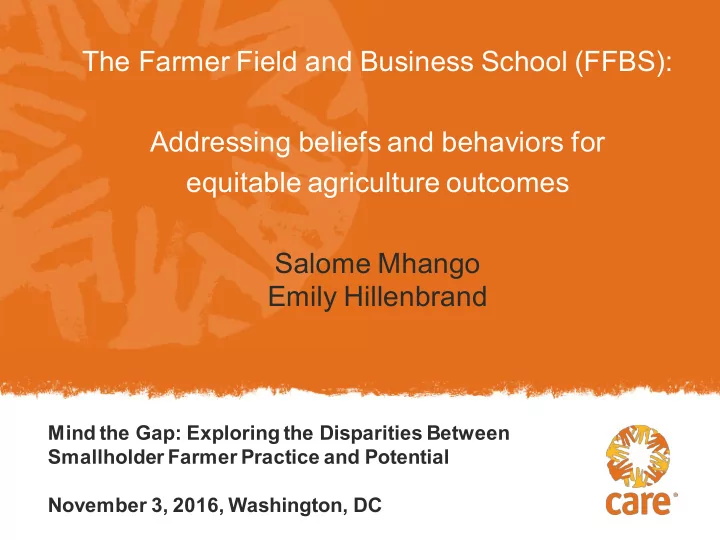

The Farmer Field and Business School (FFBS): Addressing beliefs and behaviors for equitable agriculture outcomes Salome Mhango Emily Hillenbrand Mind the Gap: Exploring the Disparities Between Smallholder Farmer Practice and Potential November 3, 2016, Washington, DC
Gender disparities in the agriculture sector http://www.fao.org/gender/infographic/en/ 1 November 14, 2016
Problem tree: Land access 2 November 14, 2016
Beliefs and behaviors that undermine female farmers Malawi Tanzania Ghana Mali Bangladesh India Small trade businesses Women are Men are generally All important The severity of Men have are seldom run by “underneath” uncomfortable with household decisions shocks is associated “supreme” power in W omen are women alone; but men because it women working are made by the with men staying a number of rather in partnership has always been outside the home, but husband head of out for longer times important decision- “underneath” men with a husband or a that way. recognize the household and in their migration making areas. family member, even if financial benefits, include education, patterns. In these because it has always Women may be the woman is the one to including resources sale of agricultural situations women ridiculed verbally if been that way. initiate the business for household food products, livestock, “are allowed” to they are seen as being idea and obtain start- for some part of the loans, marriages, visit markets more wrong in their up capital. hunger period. boy’s circumcision, frequently. decision-making. It may seem to the and girl’s excision. outside like women are making decisions, but in reality they are not. “If a woman is Women’s labor is paid Men decide on critical During difficult Women sometimes Women are If a woman is points of family size, less even for equal jobs. educated and works times, women believe they are seen generally educated and obtaining and use of Both sexes justify this consume food of “rubber stamping” as weak and works out of her out of her house her loans, major asset lower quality than what men are stating that women simply not able house her control, land others in their saying on issues at have domestic tasks husband will not be to conduct preparation and husband will not family. the local level. they must do; themselves as cropping decisions. be interested in interested in her Traditionally they When a woman wealth men do. therefore, any paid serve everyone in her anymore. increases, she likely anymore .” job they undertake the family before will have greater 3 requires more time eating themselves. decision-making November 14, 2016 to complete. though the community may “frown” on that.
Ppathways Objectives and Theory of Change Pathways Theory of Change
Farmer Field and Business School: An integrated approach
Farmer Field and Business School: Learning by doing
Soya ridging and compost application Three treatments: 1) Best practice: no ridges, manure and mulching 2) Manure on one side of ridge only 3) Traditional practice: Ridges, open a trench, manure, and cover Time-savings: 90 to 8 days 3 variants allow women to ease into new practices, decide for themselves 7
Ghana: Income calculation for the soya treatments Treatment Yield Costs Added % (Kg/Ha) Returns increase in earnings No fertilizer 1167 Actyva only 2218 315 736 113.6% Green OK only 1749 110 472 329% Inoculant + 1874 187.5 519.5 117% Actyva Inoculant only 1570 35 368 951% 8 November 14, 2016
Nutrition : Testing new recipes and gender practices Changes in nutrition behaviors: • Men and women eating together • Women and children eating the good parts of the chicken • Consuming (not selling) soya and groundnuts 9 • New soya recipes November 14, 2016 • Men sharing cooking chores
Gender: Progressive steps and do-able actions 10 November 14, 2016
Participatory monitoring and evaluation: PPT 11 November 14, 2016
Gender Progress Marker Monitoring Women: self confidence, autonomy and leadership 100% High 90% Medium 80% Low Nil 70% 60% 50% 40% 30% 20% 10% 0% Women dress women freely Women Women stop Women nicely and choose not to negotiate for doing publically look good remarry better prolonged speak out marketing casual labour against GBV 12 November 14, 2016
Reflections on adoption of new practices Behavior change is… • a process of cost-benefit calculations (including social costs and intangible benefits) • more likely to happen when people can develop and test their own “treatments” • not immediate but still measurable • encouraged through group monitoring and data analysis • easier when you identify context-specific, progressive, do-able practices Addressing the gender norms seems to amplify the agriculture productivity and income benefits 13
Recommend
More recommend